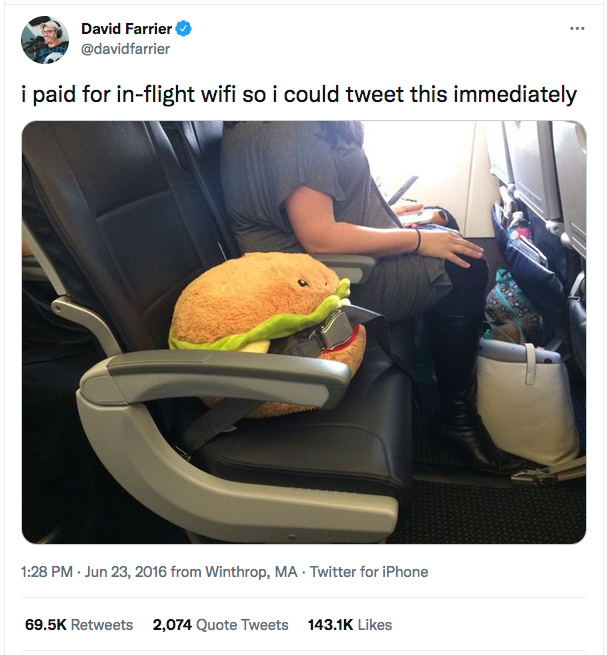Do you remember when planes first started to offer Wi-Fi to passengers? Gogo made its debut on commercial aircraft (on Virgin America – this is one of the reasons why we miss them) in 2008.
For a long time, not all airlines had Wi-Fi. Virgin America was followed by service on Alaska, Delta, and American, which was followed by other airlines as well. But for a while there, only certain planes had them (American was a good example. They started with service in about half of their 600ish planes and eventually expanded it to their entire fleet). I remember how excited I’d be when we were on a plane where I could go on the ‘net during our flight. And the things people could do with in-air Wi-Fi! Stuff like this:

https://twitter.com/davidfarrier/status/746032197342232576
The price of Wi-Fi has varied over time and airlines vary in terms of service and pricing structure (JetBlue wins on that, BTW – their Wi-Fi is free!). Upgraded Points has an excellent post about what each airline offers.
Wi-Fi on airplanes is cool, but it still has its drawbacks. It tends to be slow and spotty. On many planes it’s not even available until you reach 10,000 feet.
So Panasonic Avionics decided to do a little experiment. They wanted:
- To understand if better Wi-Fi boosted passenger loyalty;
- To see if better Wi-Fi helped airlines better understand passenger behavior;
- To evaluate whether better Wi-Fi correlates to increased revenue potential.
They partnered up with a major airline in late 2020 and gave passengers unlimited high-speed in-flight internet to see what they would do.
Not surprisingly, 88% of them streamed. Also not surprisingly, Netflix, YouTube, Spotify, AppleMusic, TikTok and Instagram Videos were the top choices of their passengers.
They didn’t announce the experiment; they just quietly turned the high-speed internet access on and watched what happened.
From Panasonic.aero:
As soon as the service became available, though, passengers discovered it. The data we collected shows that almost immediately, passengers began streaming. During the trial, average user engagement time increased by 23%, and passengers watched an average of 41 more minutes of streaming content. Meanwhile, data consumption per flight leaped from 1.6GB pre-trial to 3GB during the trial.
So what did they learn?
More satisfaction with the Wi-Fi service and higher engagement times with streaming apps can teach us a couple of things. One, that fast, reliable in-flight internet is a cornerstone of the passenger experience. Two, that heavier usage of streaming apps—via passengers’ personal devices, or the seatback screen—also gives airlines a big opportunity to increase revenue-generating ads and content.
What does it all mean? High-speed Wi-Fi will almost definitely be in our future as passengers. Whether we have to pay for it or not, and how much of a price it will be, are still huge “ifs.” But we know it’s most likely coming.
Want to comment on this post? Great! Read this first to help ensure it gets approved.
Like this post? Please share it! We have plenty more just like it and would love it if you decided to hang around and get emailed notifications of when we post. Or maybe you’d like to join our Facebook group – we have 21,000+ members, and we talk and ask questions about travel (including Disney parks), creative ways to earn frequent flyer miles and hotel points, how to save money on or for your trips, get access to travel articles you may not see otherwise, etc. Whether you’ve read our posts before or this is the first time you’re stopping by, we’re really glad you’re here and hope you come back to visit again!
This post first appeared on Your Mileage May Vary

1 comment
Good for Panasonic to take initiative on getting a better understanding of how inflight wifi can be used.
How the airlines use the data is still up in the air.